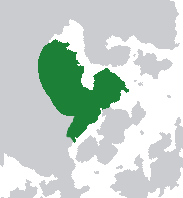Shakya
This article is incomplete because it is pending further input from participants, or it is a work-in-progress by one author. Please comment on this article's talk page to share your input, comments and questions. Note: To contribute to this article, you may need to seek help from the author(s) of this page. |
Shakyan Principalities Shakeia Mapuriti | |
|---|---|
| from 500s BCE – to 500s CE | |
|
Flag of the Shakyan Principalities (reconstructed) | |
 Map of Shakya | |
| Status | Kingdom |
| Capital | Dvaraka |
| Common languages | Shakeysian languages, including Arakaine, Kurdokaine, Nakhaine, and Sokhaine |
| Religion | Juruvanism |
| Government | Theocratic Monarchy |
| Today part of | |
The Shakyan Principalities, abbreviated to Shakya, were a loosely connected collection of about eighteen theocratic-monarchical city-states located in the geographical Oriental region of eastern Europa on Eurth.
Etymology
WIP
- https://en.wikipedia.org/wiki/Shakya#Etymology
- Our use of the name Shakya also ties into the RL Scythians. In our Eurth setting, these can be represented by the inland nomads from Burania. Presume they make irregular incursions into other lands, either to loot external riches or overcome internal hardships.
Geography
WIP
- Describe the main geographic features.
- Describe the different climate zones as display on our Eurth climate map.
- Includes an important river delta. The capital city Dvaraka was largely built on submerged land, surrounding by walls with four main gates.
- Trade with the Orient along the Jasmine Sea.
- Overland connection to nearby Amutia in the west.
History
Shakya was first home to hunting-gathering and deer herding peoples. Migrating several waves along the southern edge of the Amutian desert, the Shakyan people first settled the river delta sometime around the 21st century BCE.
(Shakyan Mandalas and princely states in present-day. Possibly related to Akiiryu. Last ruler was Sarvikas.)
WIP:
- political organisation https://en.wikipedia.org/wiki/Shakya#Shakya_administration
- Read Chalukya dynasty for some inspiration.
WIP: (( Each of the seven main principalities would be ruled by several sometimes-overlapping dynasties, on ocassion one would assert dominance over the others, however each city generally would quickly regain their independence.
Each mandala or city-centered region of Shakya was associated with a Pre-reformed Juruvanic anthropomorphic deity.
- Baviru Puri: Horned Serpent
- ___ Puri: Abyssal Scorpion
- ___ Puri: Jackal
- Dvaraka Puri: Golden Stag
- ___ Puri: Hedgehog
- ___ Puri: Eagle
- Kadofari Puri: Skull Frog
- ___ Puri: Ox
- ___ Puri:
- ___ Puri:
- ___ Puri: Dragon Fly
- ___ Puri: Leopard
- ___ Puri: Bat
- ___ Puri:
- ___ Puri:
- ___ Puri: Hummingbird
- ___ Puri: Peacock
- ___ Puri:
Grand-Prince [Azhidahoka] "Mardoush" (= The Snake-Shouldered) Gaiomardikin of the ancient coastal city of Baviru, by the Jasmine Sea coast, was able to unite through military conquest and diplomatic maneuverings (!married the Princess of the Scorpion city) the various Shakyan entities for a short period, including the other six main Principalities or Mapuritis. Legend states that Azhidahoka began as a strong, intelligent, generous and expansionist ruler, however he quickly began experiencing bouts of delusional episodes and fervent paranoia. He allegedly began engaging in ritualistic cannibalism of the priestly and nobility classes in a supposed attempt to live forever.
A blacksmith by the name of Kaova eventually assassinated Grand-Prince Azhidahoka Gaiomardikin which brought about 30 years of political instability, famine, and a series of wars as various prinicpalities vied for power in the vaccuum.
During the three-decade long chaos, a self-declared prophet by the name of Mazhdika began prophesing a pseudo-atheistic religion based on a form of pacifist altruistic-hedonism, Akhishidinism throughout the principalities. This movement greatly upsetted the clergy and minor nobility which began violently opressing the quickly growing movement. Despite this, Kavodh, a son of Kaova, converted to Akhishidinism and with the support of Mazhdika's followers and (!Foreign mercenaries) was able to end Baviru's chaos and bring a semblance of peace. Prince Kavodh elevated and helped spread Mazhdika's teachings throughout the Northern principalities for a while until his death. While Prince Kavodh laid on his deathbed, his two eldest sons began campaigning for their right to rule Baviru, the presumptive heir Kaovosh and younger brother Khosruo both formed their alliances and eventually prepared for war. During this tenuous moment, Mazhdika would be invited by Khosruo on the pretext to discuss poeaceful negotiations and to admire "a new garden with unusually exotic trees". Soon after Mazhdika's arrival, and upon stepping into the nearby grove, Mazhdika fainted upon seeing 5.000 flayed, impaled, and upside down men, women and children bodies of Akhishis with their heads covered in the ground. Mazhdika was then tied upside down and is said to have been shot at by a thousand arrows. On the eve of the battle, Kaovosh gave himself in to his brother citing the love between brothers. Khosruo, on the otherhand, now under the influences of the firmly reestablished clergy and minor nobility offered Kaovosh the opportunity to denounce Mazhdika and his teachings, which Kaovosh did not take. Kaovosh was then burned at the stake as a heretic.
Khosruo's oppression of the Akhishis crossed borders and thouands of followers were mercilessly slaughtered. Several Akhishis however did manage to flee the Shakyan Prinicipalities toward the Orioni empire. Today, the Sokhaineans, the numerically dominant ethnicity in Safiloa are partially creolized with strong Azanian and Marenesian influences but are still considered to be linguistically, culturally, religiously, and spiritually the direct descendants of Mazhdika's followers. ))
Economy
(Shakyan soil is rich with raw materials, containing large deposits of oil, gas, coal, diamonds, gold, silver, tin and many others. Sakha produces over 25% of the diamonds mined in the wurld.)



